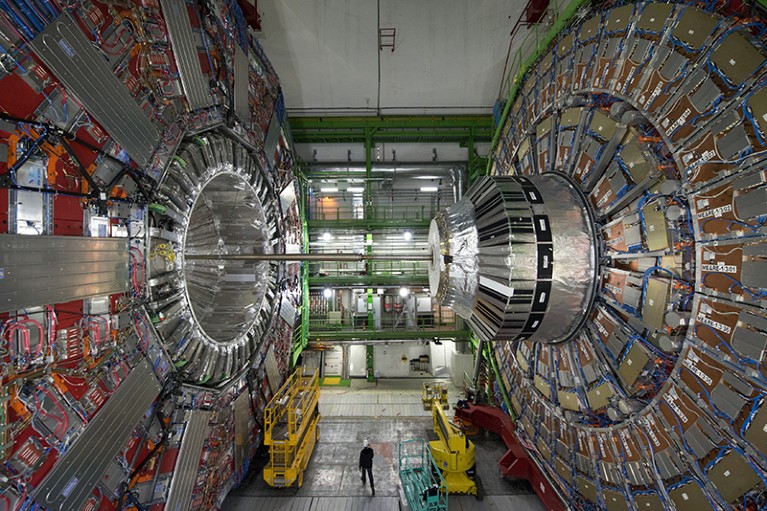
The Compact Muon Solenoid (CMS) detector enabled the discovery of the Higgs boson at CERN, Europe’s particle-physics lab near Geneva.Credit: Richard Juilliart/AFP via Getty
Roughly 100 metres underground, in a tunnel that crosses the border between Switzerland and France, lies the largest machine ever built. The Large Hadron Collider (LHC) compresses and collides tiny bits of matter to recreate the fundamental particles that appeared just one-trillionth of a second after the Universe was created.
It’s all part of a day’s work at CERN, Europe’s particle-physics laboratory near Geneva, which is home to the LHC. The lab, which celebrates its 70th anniversary this year, continues to attract scientists who are eager to uncover the nature of particles that comprise matter. Along with more than 2,600 staff members and 900 fellows, CERN hosted nearly 12,000 visiting scientists from 82 countries in 2022. According to indexed papers on the Web of Science database, the researchers publish, on average, around 1,000 papers each year that explore the origin of the Universe, antimatter, dark matter, supersymmetry and beyond. And their ranks include eminent scientists such as Tim Berners-Lee, credited with inventing the World Wide Web, and physicist Peter Higgs, who died on 8 April.
Peter Higgs obituary: physicist who predicted boson that explains why particles have mass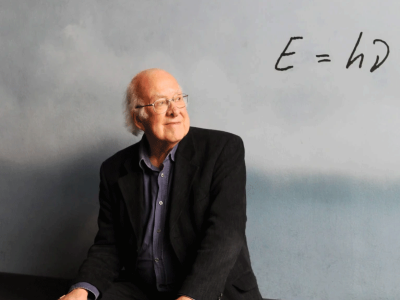
“Particle physics is basically exploring back in time,” says Alain Blondel, a particle physicist who has worked at CERN and the University of Geneva in Switzerland. “The science we do, together with cosmology, astrophysics and many other fields, explores how the Universe was born and how it works. These are questions that have fascinated people for generations”.
Discoveries made at CERN, such as the production of antihydrogen and the development of the World Wide Web, have affected not only the scientific world, but society as a whole. Yet, the inaccessibility of CERN to the majority of the public has led to an almost mythical perception of the organization, says Andri Pol, a photographer based in Switzerland. Pol spent two years capturing the inner workings of CERN for his 2014 book Inside CERN. “You jump into another world and you feel like an alien,” he says. “I don’t know anything about physics, chemistry or mathematics. But you feel the creativity. There’s a lot of energy not only in the machines, but also the people.”
Brain gain
Retaining and attracting scientific talent was a key driving force behind the creation of CERN. During and after the Second World War, many scientists fled Europe to pursue careers in the United States. In the early 1950s, a small group of European scientists put forth a proposal to create a physics laboratory to unite scientists throughout Europe. On 29 September 1954, 12 member states signed a convention establishing CERN near Geneva (see ‘CERN’S growth’).
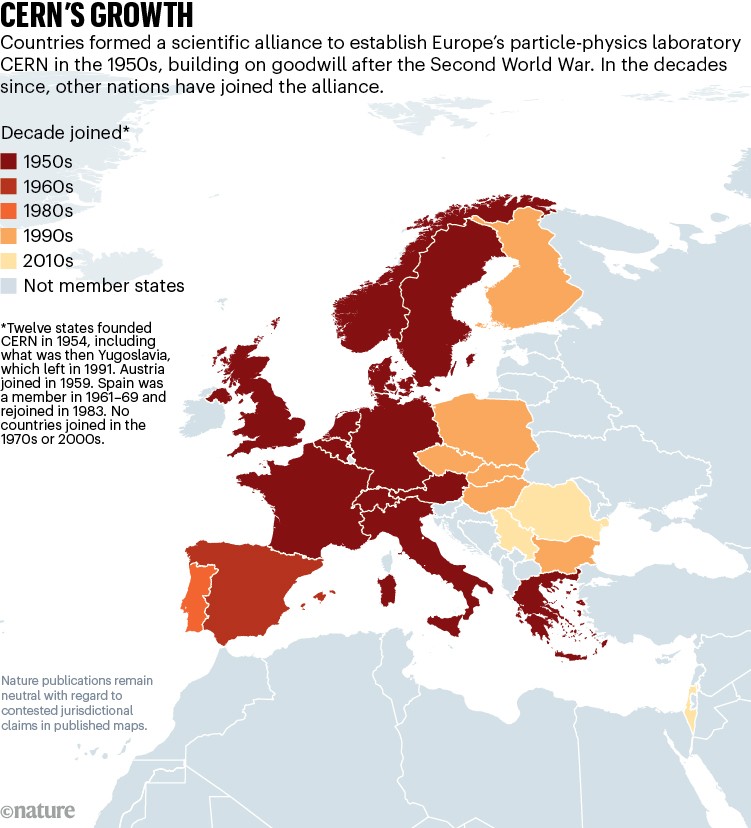
Source: CERN
Part of the decision to build CERN in Switzerland was the country’s central location in Europe and its neutrality during the war. In fact, CERN’s convention states, “The Organization shall have no concern with work for military requirements.”
“CERN has this aspect of science for peace,” says Rainer Wallny, a physicist at the Swiss Federal Institute of Technology (ETH) Zurich who chaired the Swiss Institute of Particle Physics in 2020–21. “You are not doing anything military related; you work for the curiosity.”
Now, CERN is governed by a council of 23 member states that provide financial contributions and make decisions regarding the organization’s activities, budget and programmes. CERN’s projected annual revenue for 2023 was 1.39 billion Swiss francs (US$1.53 billion), all of which it spends.“I think it is a great model for international collaboration,” says Wallny. “It has a lot of facilities available that are beyond the scope of individual user groups. No one has a particle accelerator in their backyard.”
The LHC, which is the most powerful particle accelerator in the world, consists of a 27-kilometre ring of superconducting magnets. Inside, two particle beams shoot trillions of protons towards one another at nearly the speed of light, causing some to collide and transform their energy into new particles. Along with the LHC, CERN has eight other particle accelerators, two decelerators, an antimatter factory and a vast array of engineering and computing infrastructure.
These resources bring together thousands of scientists from around the world to tackle big questions in particle physics. Research efforts at CERN led to the discovery of weak neutral currents in 1973, the W and Z bosons in 1983 and three types of neutrino in 19891–3. These findings provided support for the standard model of physics, a theory developed in the 1970s that describes the fundamental particles of the Universe and the four forces that shape their interactions. Then, in July 2012, scientists at CERN found evidence for the last key force in the standard model — the Higgs boson4.
“I’m fascinated by the concept of having these large, international collaborations working on a scientific puzzle,” says Lea Caminada, a particle physicist at the University of Zurich and the Paul Scherrer Institute in Villigen, Switzerland. Caminada and her research group develop pixel detectors for the Compact Muon Solenoid (CMS), a particle detector experiment at the LHC that does research on the standard model, dark matter and extra dimensions. “Doing high-energy physics is unique. It’s really the energy frontier, and there is no other facility in the world where you can do this,” she says.
The CMS collaboration involves more than 5,900 physicists, engineers, technicians and students from 259 institutions across 60 countries. The collaboration publishes around 100 papers each year and celebrated its 1,000th publication in November 2020. But organizing and contributing to large-scale projects is no simple feat. “It’s not always easy to work at CERN. It’s very hard to organize experiments this big,” Caminada says. For instance, she explains, everyone involved in the CMS experiment can review manuscript drafts and provide feedback before submission of a paper. “But I think it creates opportunities for people in different countries.”
A fount of knowledge
Thea Klæboe Åarrestad’s first experience at CERN was during an undergraduate internship in July 2012. During the paid programme, she took three weeks of classes, met with fellow physicists and attended lectures from specialists in the field. It also happened to be the year CERN announced the discovery of the Higgs boson. “Peter Higgs was there. The press of the free world was there. People were sleeping in lines outside the main auditorium to catch the speech,” she says.
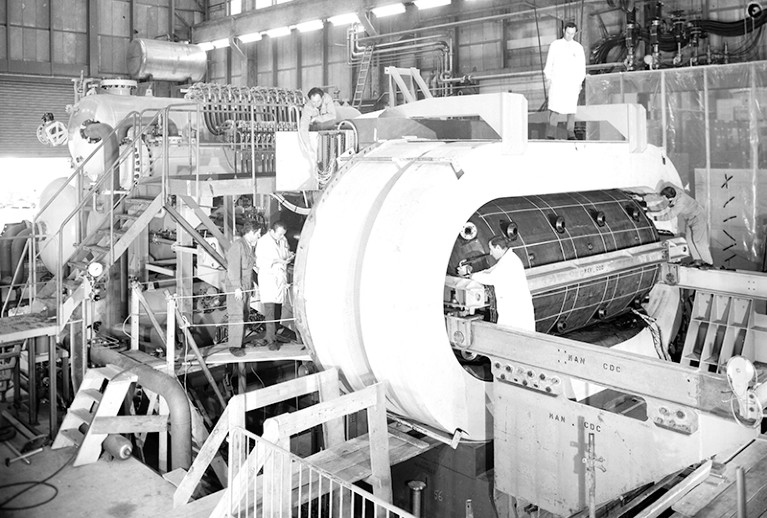
The Gargamelle chamber at CERN, operational during the 1970s, detected neutrinos.Credit: CERN PhotoLab
Åarrestad went on to earn her PhD from the University of Zurich in 2019, where she worked on the CMS experiment at CERN, and then became a research fellow at CERN from 2019 to 2021. “My daughter was five months old when I started commuting to CERN. I spent eight hours on the train every day,” she says. “My friends questioned whether I could do exactly the same work for a company, and I can honestly say no, I can’t.”
Now, as a particle physicist at ETH Zurich, Åarrestad studies how to use machine learning to improve data collection and analysis methods at CERN. “The environment there is fantastic. You go for a coffee and everyone has ideas and thoughts to discuss. I was always very passionate about physics, and being at CERN just made me even more passionate about it because I shared it with so many others,” she says.
Reverberating impacts
The impact of CERN goes well beyond the smashing together of tiny particles. “Such a vibrant intellectual node radiates out to the universities,” says Wallny. He often sends his graduate students to CERN, where they can gain experience in a large, international setting. “There’s a lot of education happening, and not just in science and engineering. You interact with people from other cultures and learn how to express yourself in English,” he adds.
According to Wallny, lessons from organizing large-scale collaborations at CERN can also be applied to other areas of science, such as quantum computing. “In these large experiments, you have to invent your own governance. You have a bunch of usually quite anarchistic academics who still have to play by some rules. You have to give yourself a constitution and a collaboration board. These approaches can easily be copied in other emerging fields of science,” he says.
Investing in projects such as CERN has benefits for society that expand beyond the bounds of academia. Massimo Florio, an economist at the University of Milan in Italy, calculates the costs and benefits of large-scale research infrastructure projects. In 2018, Florio and his colleagues evaluated how procurement orders from CERN for the production of the LHC affected knowledge production, patent filings, sales and profits for more than 350 supplier companies5.
“There is clear evidence that after they got an order from CERN, even 10 years later, it was transformative for them,” says Florio. “Even if you give zero value to the discovery of the Higgs boson, the knowledge generated along the way has immediate benefits to society.”
Over the past 70 years, technologies developed at CERN to tackle technical and computing challenges have been applied throughout the world. Perhaps the most notable is the World Wide Web, which was developed by computer scientist Tim Berners-Lee in 1989 to rapidly share knowledge among scientists. In medicine, the technologies from particle accelerators and detectors are used in positron emission tomography scanners and radiation methods for cancer treatments, such as hadron therapy6.
Satisfying curiosity
As CERN embarks on its eighth decade of research, the organization is planning to upgrade its accelerators to add to knowledge about the fundamental particles that make up the Universe. Towards the end of 2025, the LHC will be shut down and upgraded to a high-luminosity LHC over about four years. The upgrades aim to increase the machine’s luminosity tenfold, which would result in a larger number of collisions, allowing scientists to observe new events and rare events, such as those producing a Higgs boson, in more detail. “If we’re ever going to produce new physics, we need a lot of data. And in order to get a lot of data, we need more collisions,” says Åarrestad. She notes that upgrades to the LHC will result in almost quadruple the number of collisions that occur now.
Feasibility studies are also being conducted for the potential development of the Future Collision Collider (FCC), a massive, 91-kilometre particle accelerator7. A later phase of the proposed FCC is a hadron collider that could have roughly seven times the collision energy of the LHC. But there are concerns about the costs and environmental impacts of the FCC proposals8, as well as particle-physics research more broadly. “There are a lot of humans that would benefit from that money. It costs energy and affects the environment to do fundamental physics,” says Åarrestad. “But I think it is something we should continue in the future despite the cost and the energy consumption, because in the end, as humans, what are we if we’re not curious about where we’re from?”
Furthermore, says Pol, basic research often leads to real-world advances. “Sometimes, something new comes out of basic, theoretical research — one never knows. So, you have to give people who are really skilled a chance to try and find out what makes us what we are,” he says.
That sentiment holds for non-scientists, as well. While working on a contribution to the 2023 book Collisions: Stories from the Science of CERN, Lucy Caldwell, a novelist and playwright based in Ireland, had the opportunity to visit the organization. There, she met several scientists and published a fictional piece on the basis of her experiences. “As humankind, we tend to tell the same stories over and over in different variations,” she says. “Being able to go somewhere like CERN and talk to the scientists right at the cutting edge of knowledge gives you, as a writer, new images, new words and new concepts. It gives you ways to make old stories fresh again and ways to tell new stories. And I think that’s important for all of us.”

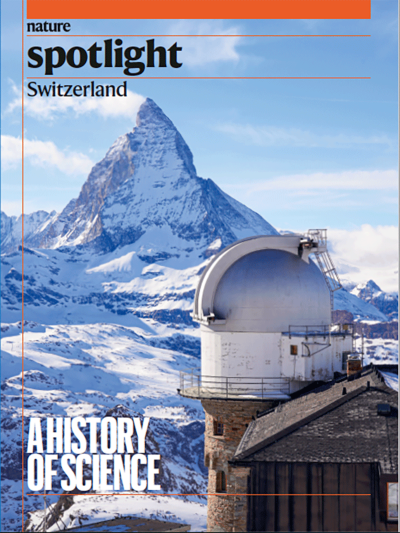
 Deadly diseases and inflatable suits: how I found my niche in virology research
Deadly diseases and inflatable suits: how I found my niche in virology research
 I dive for fish in the longest freshwater lake in the world
I dive for fish in the longest freshwater lake in the world
 How young people benefit from Swiss apprenticeships
How young people benefit from Swiss apprenticeships








